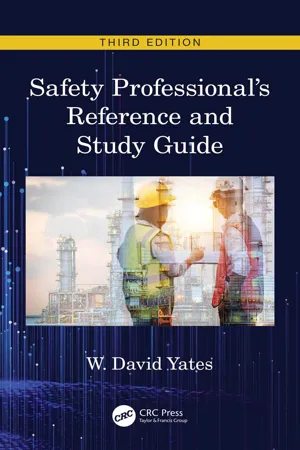
- 882 pages
- English
- ePUB (mobile friendly)
- Available on iOS & Android
Safety Professional's Reference and Study Guide, Third Edition
About this book
This new edition serves both as a reference guide for the experienced professional and as a preparation source for those desiring certifications. It's an invaluable resource and a must-have addition to every safety professional's library.
Safety Professional's Reference and Study Guide, Third Edition, is written to serve as a useful reference tool for the experienced practicing safety professional, as well as a study guide for university students and those preparing for the Certified Safety Professional examination. It addresses major topics of the safety and health profession and includes the latest version of the Board of Certified Safety Professional (BCSP) reference sheet, a directory of resources and associations, as well as state and federal agency contact information. Additionally, this new edition offers new chapters and resources that will delight every reader.
This book aids the prospective examination candidate and the practicing safety professional, by showing them, step-by-step, how to solve each question/formula listed on the BCSP examination and provide examples on how and when to utilize them.
Frequently asked questions
- Essential is ideal for learners and professionals who enjoy exploring a wide range of subjects. Access the Essential Library with 800,000+ trusted titles and best-sellers across business, personal growth, and the humanities. Includes unlimited reading time and Standard Read Aloud voice.
- Complete: Perfect for advanced learners and researchers needing full, unrestricted access. Unlock 1.4M+ books across hundreds of subjects, including academic and specialized titles. The Complete Plan also includes advanced features like Premium Read Aloud and Research Assistant.
Please note we cannot support devices running on iOS 13 and Android 7 or earlier. Learn more about using the app.
Information
1
The Safety Profession and Preparing for the ASP/CSP Exam
Board of Certified Safety Professionals
- Evaluate the academic and professional experience qualifications of safety professionals,
- Administer examinations,
- Issue certifications to those professionals who meet the Board’s criteria and successfully pass required examinations.
- American Industrial Hygiene Association,
- American Society of Safety Engineers,
- Institute of Industrial Engineers,
- National Fire Protection Association,
- National Safety Council,
- Society of Fire Protection Engineers,
- System Safety Society.
Definitions
Table of contents
- Cover
- Half Title
- Title Page
- Copyright Page
- Dedication
- Table of Contents
- Preface
- Author
- 1. The Safety Profession and Preparing for the ASP/CSP Exam
- 2. Regulations
- 3. Math Review
- 4. Particulates and Gases
- 5. Toxicology
- 6. Industrial Hygiene Air Sampling
- 7. Ventilation
- 8. Noise and OSHA’s Hearing Conservation Program
- 9. Biological Hazards
- 10. Fire Protection and Prevention
- 11. Thermal Stressors
- 12. Personal Protective Equipment
- 13. Statistics for the Safety Professional
- 14. Electrical Safety
- 15. Mechanics
- 16. Hydrostatics and Hydraulics
- 17. Training
- 18. Engineering Economics
- 19. Management Theories
- 20. Accident Causation and Investigation Techniques
- 21. Workers’ Compensation
- 22. Ergonomics
- 23. Construction Safety
- 24. Risk Assessment and Management
- 25. Hazardous Materials Management
- 26. Radiation Safety
- 27. Walking and Working Surfaces
- 28. Materials Handling and Storage
- 29. Safety Management System
- 30. Site Security
- 31. Behavior-Based Safety
- 32. Measuring Health and Safety Performance
- 33. Safety Program Auditing Techniques and Checklist
- 34. Environmental Management
- 35. BCSP Code of Ethics
- Appendix A: BCSP Supplied Equations
- Appendix B: Conversions and Standards
- Appendix C: OSHA Regional and Area Offices
- Index